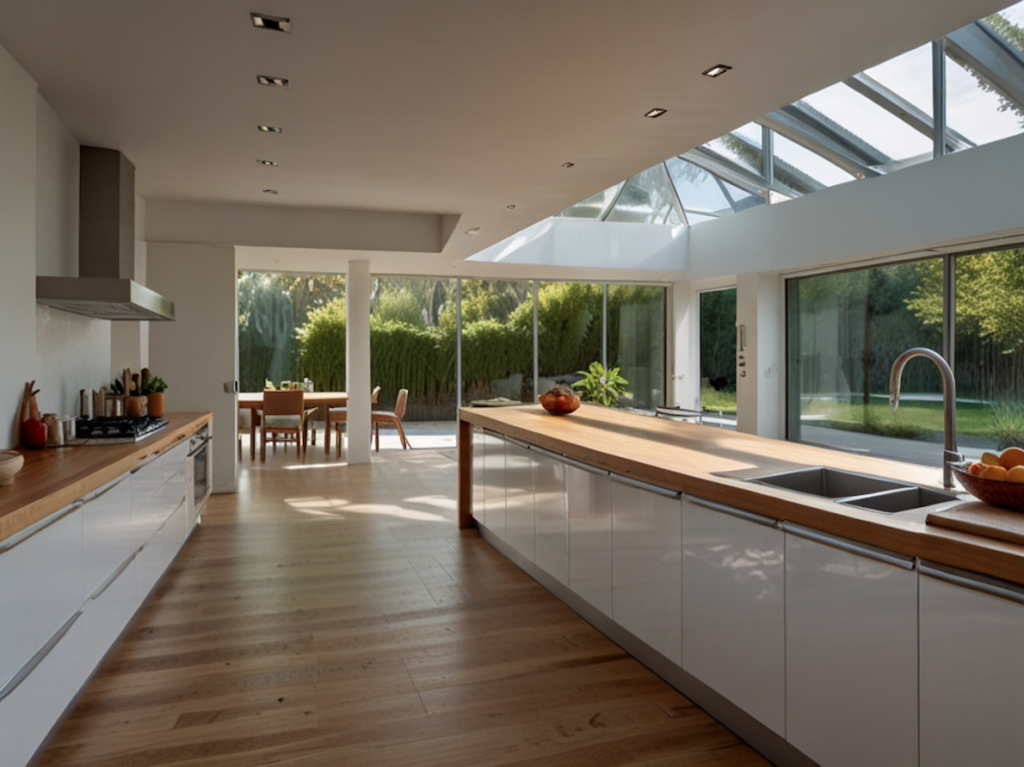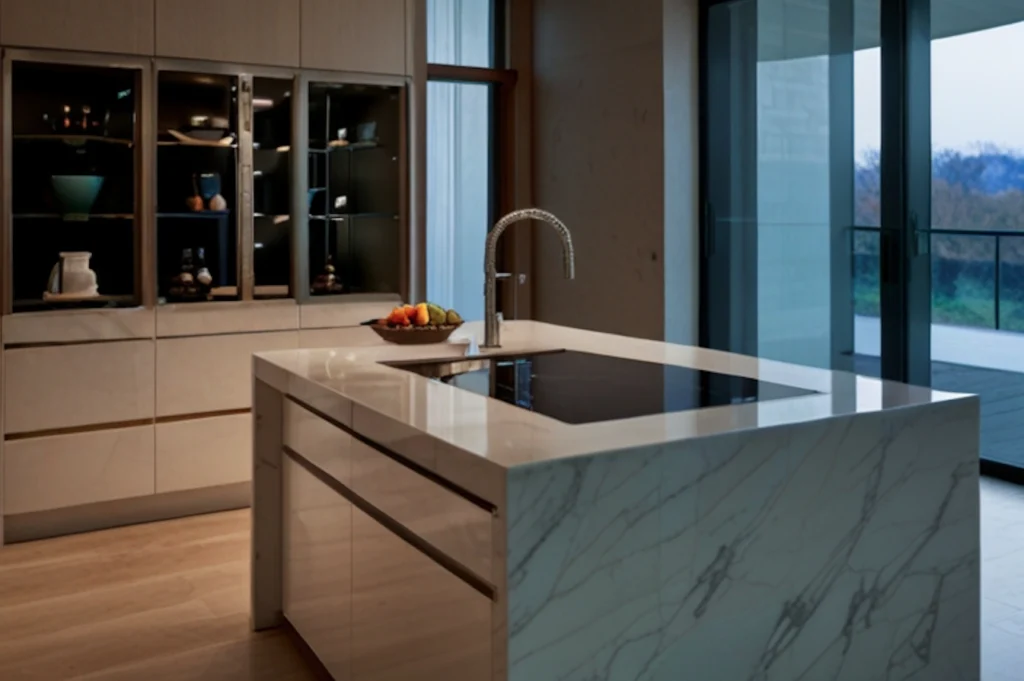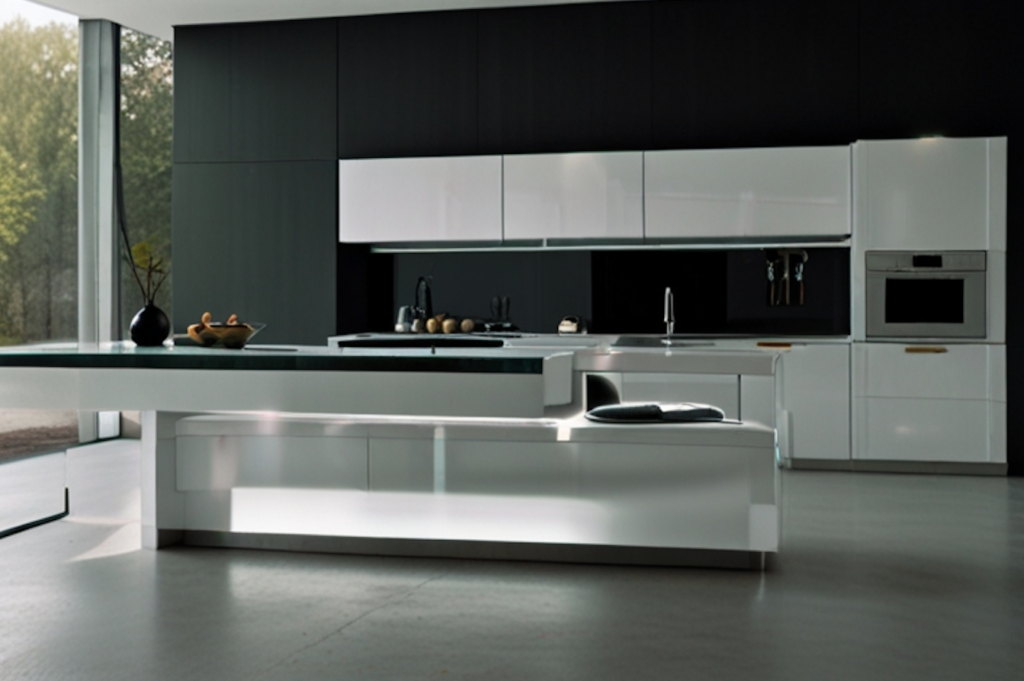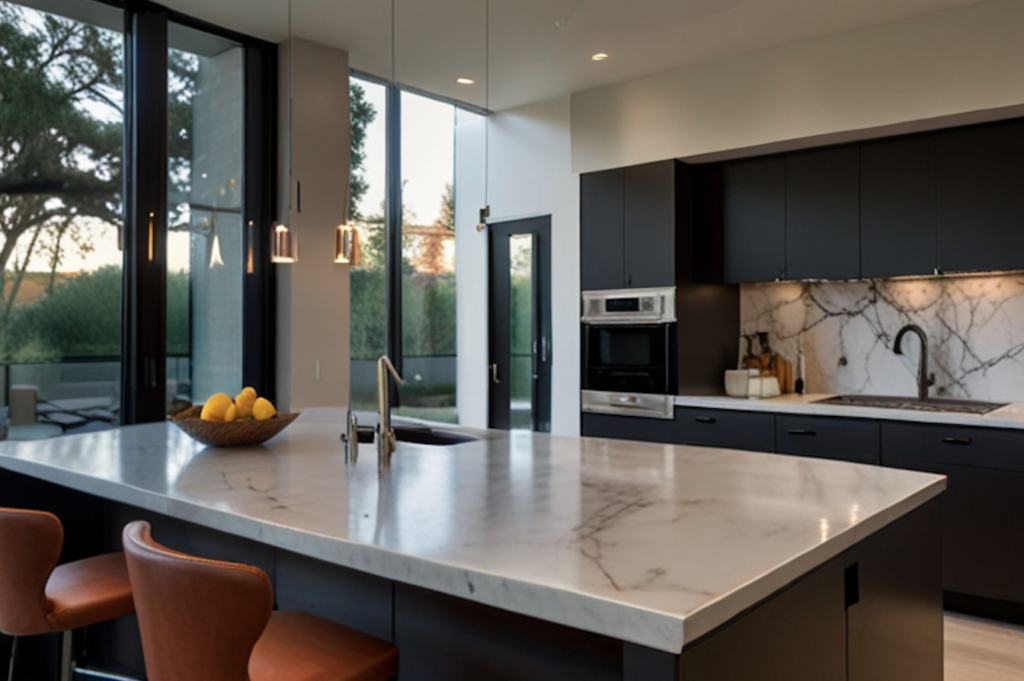Sustainability is a growing concern, and it’s becoming increasingly important to incorporate eco-friendly practices into our everyday lives. This applies to our kitchens as well! An eco-friendly kitchen design doesn’t just benefit the environment; it can also save you money on utility bills and create a healthier cooking space. Here, we’ll explore various ways to design a sustainable kitchen, focusing on materials, water conservation, energy efficiency, and responsible practices.
The first step towards an eco-friendly kitchen is choosing the right materials for your cabinets, countertops, and flooring. Let’s delve into sustainable options for these crucial elements in the next section.
Sustainable Materials: Building a Green Foundation
The materials you choose for your kitchen play a significant role in its environmental impact. Here’s a breakdown of eco-friendly alternatives for countertops, cabinets, and flooring:
Countertops:
- Traditional Choices: Granite and marble countertops are beautiful and durable, but their quarrying and transportation processes can have a significant environmental impact.
Eco-Friendly Alternatives:
- Recycled Glass: Crushed recycled glass is bonded together with resin to create stunning countertops with a unique aesthetic. They are durable, stain-resistant, and come in a variety of colors.
- Quartz: Composed of recycled materials like crushed quartz and resin, quartz countertops are highly durable, non-porous, and require minimal maintenance.
- Bamboo: A rapidly renewable resource, bamboo is a sustainable choice for countertops. It’s naturally antibacterial and offers a warm, contemporary look.
- Bonus Option: Reclaimed wood countertops offer a unique and eco-friendly option. Ensure the wood is sourced from reputable salvage companies to minimize environmental impact.
Cabinets:
- Sustainable Considerations: Look for cabinets made from wood harvested from forests certified by the Forest Stewardship Council (FSC). FSC certification ensures responsible forestry practices that preserve biodiversity and ecosystems.
- Eco-Friendly Options:
- FSC-Certified Wood: Choosing cabinets made from FSC-certified wood ensures your kitchen doesn’t contribute to deforestation.
- Reclaimed Wood: Salvaged wood from old barns or furniture adds a touch of character and history to your kitchen while reducing demand for new wood.
- Recycled Materials: Some manufacturers offer cabinets made from recycled materials like plastic or agricultural byproducts.
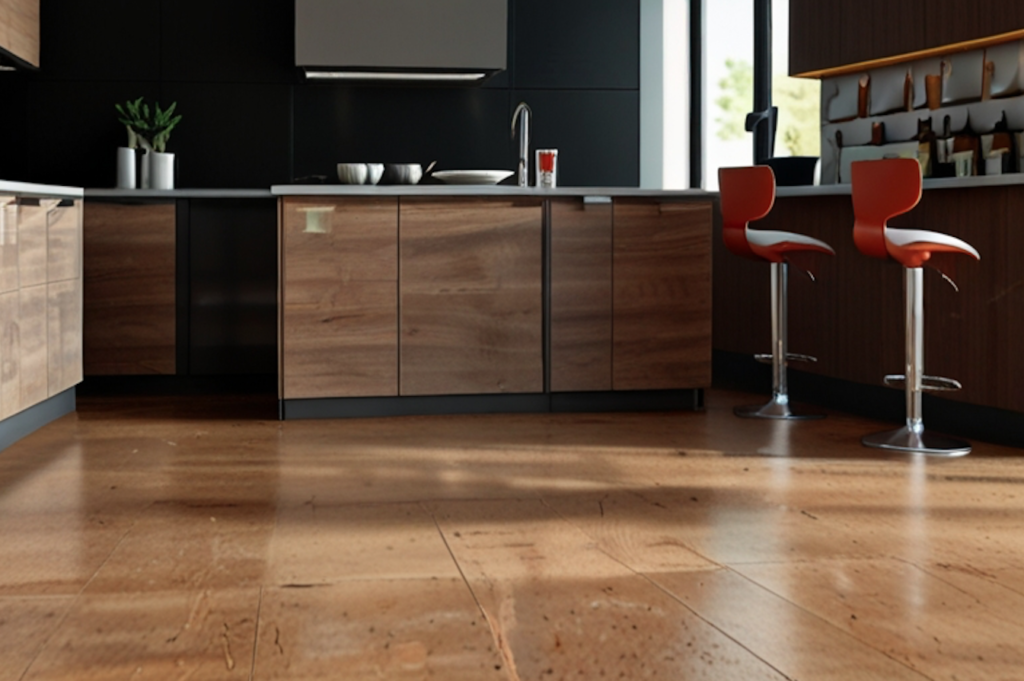
Flooring:
- Traditional Concerns: Vinyl and laminate flooring are affordable but can contain harmful chemicals and are not always recyclable.
- Eco-Friendly Alternatives:
- Cork: This naturally renewable resource provides excellent sound insulation and is comfortable underfoot. Cork flooring is also naturally water-resistant and easy to maintain.
Bamboo: As mentioned for countertops, bamboo flooring is a
- sustainable and durable option. It’s naturally stain-resistant and adds a touch of warmth to the kitchen.
- Recycled Wood: Reclaimed wood flooring adds a unique character and reduces reliance on new wood sources. Choose pre-finished options for easier installation.
- Bonus Option: Natural stone flooring like slate or tile offers a timeless look and can last a lifetime. Look for locally sourced stone to minimize transportation impact.
By choosing sustainable materials for your kitchen, you’re not only creating a beautiful space but also minimizing your environmental footprint.
Water Conservation: Every Drop Counts in the Kitchen
The kitchen is a significant source of water usage in a home. By implementing a few simple practices, you can significantly reduce your water consumption and contribute to a more sustainable future. Here are some key strategies for water conservation in the kitchen:
- Low-Flow Fixtures: Installing low-flow faucets and showerheads can dramatically reduce water usage without compromising functionality. Look for fixtures labeled with the Environmental Protection Agency’s (EPA) WaterSense label. These products are independently certified to meet strict water efficiency criteria.
- Consider installing an aerator on your existing faucet. This inexpensive attachment can significantly reduce water flow without affecting water pressure.
- Water-Saving Appliances: Modern dishwashers and washing machines are significantly more water-efficient than older models. When replacing appliances, look for Energy Star-certified models that meet rigorous water and energy efficiency standards.
- Smart Dishwashing: Don’t pre-rinse dishes before loading them in the dishwasher. Modern dishwashers are designed to handle food scraps effectively. Run the dishwasher only when it’s full to maximize water efficiency.
- Thoughtful Food Preparation: When washing fruits and vegetables, fill a basin with water instead of letting the tap run continuously. You can also reuse the rinse water for watering plants. Thaw frozen food in the refrigerator overnight instead of running it under hot water.
- Fixing Leaks: Even a small leak can waste a significant amount of water over time. Regularly check your faucets and pipes for leaks and repair them promptly.
By incorporating these simple water conservation strategies into your kitchen routine, you can make a big difference in reducing your environmental impact.
Energy Efficiency: Powering Your Sustainable Kitchen
Modern appliances and smart design choices can significantly reduce your kitchen’s energy consumption and save you money on utility bills. Here are some key areas to focus on for an energy-efficient kitchen:
Energy Star Appliances: Look for the Energy Star label when purchasing new appliances. Energy Star-certified appliances meet strict energy efficiency standards, resulting in significant energy cost savings over their lifetime. This applies to refrigerators, ovens, dishwashers, and even ventilation fans.
- Smart Appliance Features: Many modern appliances come equipped with features that can help you save energy. For example, some refrigerators have an “eco mode” that reduces energy consumption when not in use. Ovens with automatic shut-off features prevent wasted energy from accidentally leaving them on.
- Cooktop Choices: Induction cooktops offer superior energy efficiency compared to traditional gas or electric ranges. They transfer heat directly to the cookware, minimizing wasted energy.
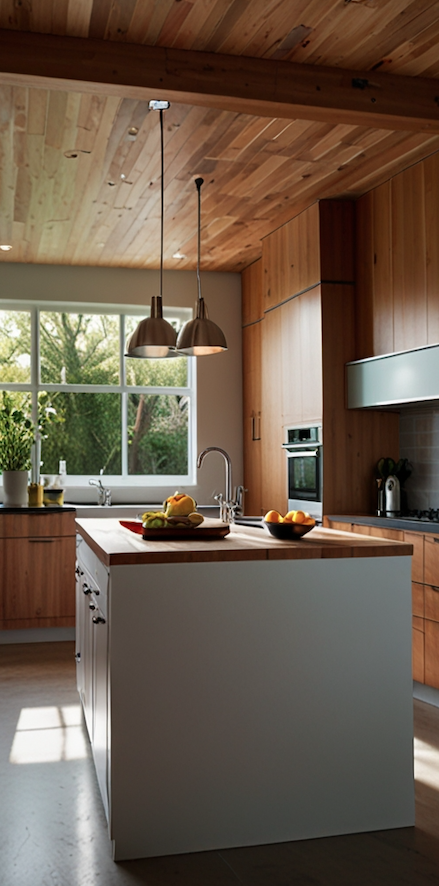
- Lighting is Key: Replace traditional incandescent bulbs with energy-efficient LED bulbs. LED bulbs use significantly less energy while providing comparable brightness.
- Strategic Ventilation: Use your exhaust fan only when necessary. While essential for removing cooking odors and fumes, exhaust fans also expel conditioned air from your home.
- Smart Power Strips: Plug appliances into smart power strips that can automatically cut power to electronics when not in use. This eliminates standby power consumption, often referred to as “phantom energy drain.”
By implementing these energy-efficient practices, you can create a more sustainable kitchen that saves you money and reduces your environmental impact.
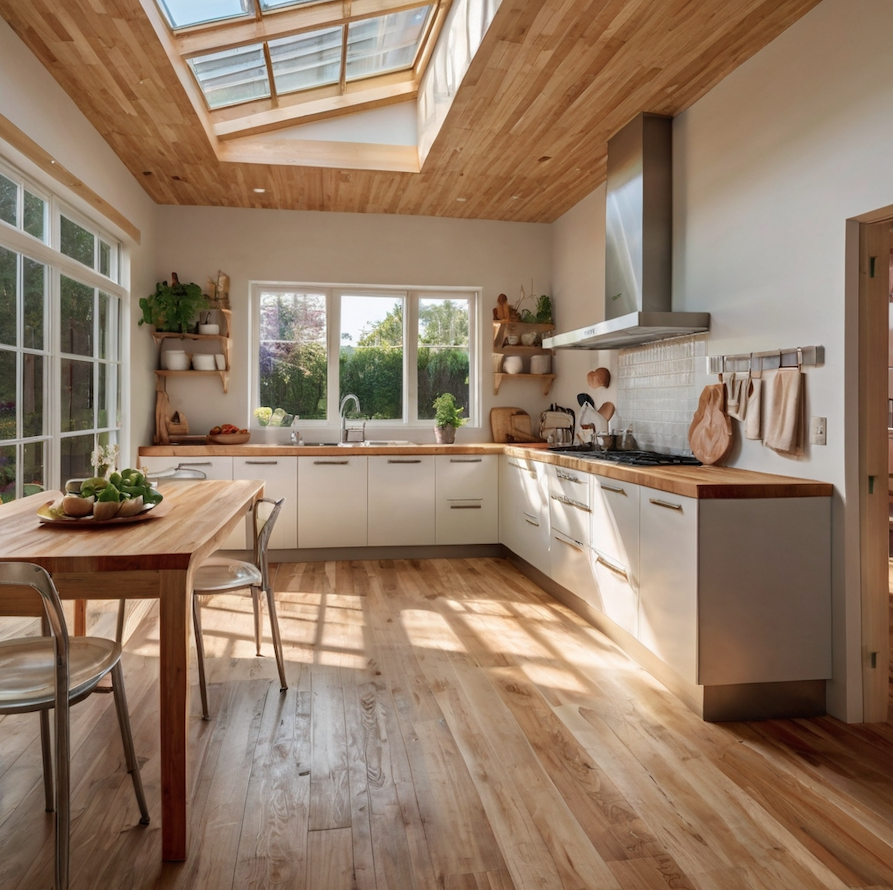
Natural Light: Brightening Your Kitchen and Reducing Energy Use
Natural light serves a dual purpose in your eco-friendly kitchen. It not only creates a brighter, more inviting space but also significantly reduces your reliance on artificial lighting. Here are some strategies to maximize natural light in your kitchen:
- Embrace Windows: Keep your existing windows clean and uncovered to allow maximum natural light to enter the space. Consider the size and placement of windows during a renovation. Larger windows or strategically placed windows facing south can significantly brighten your kitchen.
- Skylights are Saviors: Especially in kitchens with limited wall space for windows, skylights can be a game-changer. They bring natural light directly from above, illuminating even the darkest corners of your kitchen. Velux and SunTunnel are well-known skylight brands to explore.
- Floor-to-Ceiling Wow: If you have the opportunity for a major renovation, consider incorporating floor-to-ceiling windows. This creates a dramatic visual impact and bathes the entire kitchen in natural light. However, keep in mind potential drawbacks like increased heat gain in summer and privacy concerns depending on your location.
- Light Shelves and Transoms: Light shelves are essentially horizontal shelves installed above windows. They reflect sunlight deeper into the room, brightening areas further from the window. Transoms are small windows placed above doorways or cabinets, allowing light to flow between rooms.
By incorporating these natural light strategies, you can create a beautiful, light-filled kitchen that reduces your dependence on artificial lighting and lowers your energy consumption.
Additional Tips and Considerations for a Sustainable Kitchen:
While we’ve covered core principles for an eco-friendly kitchen, here are some additional tips to consider:
- Reduce Food Waste: Plan your meals, create shopping lists, and utilize proper storage techniques to minimize food waste. Composting leftover food scraps and using them for gardening is a great way to close the loop and reduce waste going to landfills.
- Reusable is Key: Ditch disposable products like plastic wrap, aluminum foil, and single-use containers. Invest in reusable containers for storing leftovers and packing lunches. Use cloth napkins and dish towels instead of paper products.
- Responsible Disposal: When replacing old appliances or electronics, dispose of them responsibly through certified recycling centers. This prevents harmful materials from entering landfills and ensures proper processing for future use.
- Green Cleaning Products: Opt for eco-friendly cleaning products that are free of harsh chemicals. These products are better for your health and the environment. You can even create your own natural cleaning solutions using vinegar, baking soda, and lemon juice.
- Sustainable Maintenance: Regularly maintain your appliances to ensure they operate efficiently. Clean refrigerator coils, replace dishwasher filters, and properly maintain your oven to maximize their lifespan and energy efficiency.
By incorporating these additional practices, you can go beyond the basics and create a truly sustainable kitchen that minimizes your environmental impact while fostering a healthy and responsible cooking environment.
Conclusion:
Creating a sustainable kitchen doesn’t require a complete overhaul. Even small changes, like choosing eco-friendly materials, conserving water, and utilizing energy-efficient appliances, can make a significant difference. By embracing these practices, you can create a beautiful and functional kitchen that benefits the environment, saves you money, and contributes to a greener future. So, get creative, explore sustainable options, and embark on your journey towards an eco-friendly kitchen!

